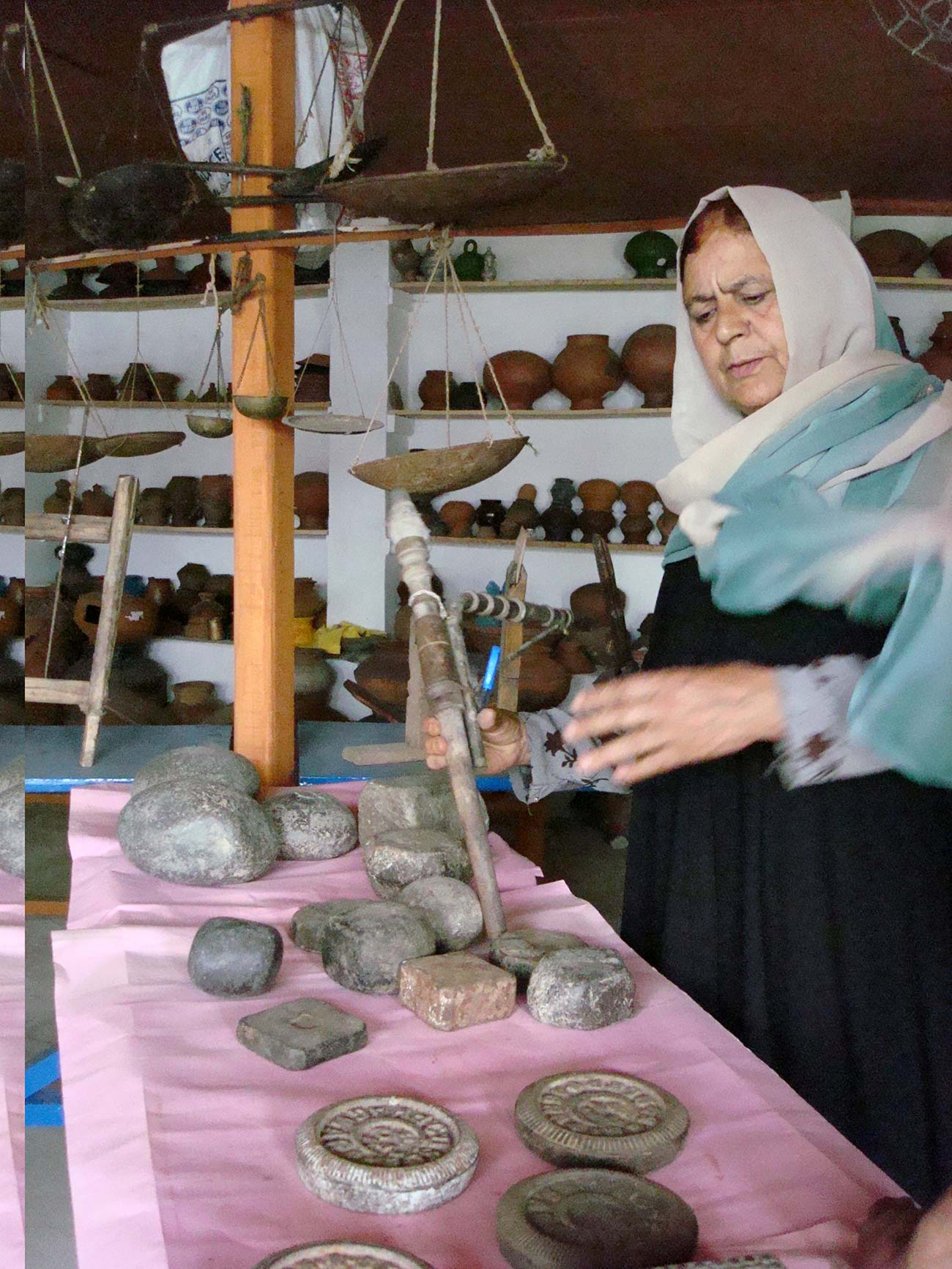At an age when people retire, Atiqa Bano set up a museum to preserve and display rare artefacts and manuscripts of Kashmir. Majid Maqbool reports.

(Atiq Banoo in the heritage palace she built)
Three modest rooms and two tin sheds inside a private B. Ed. College in Noorbagh Sopore comprises Meeras Mahal (Heritage Palace). Inside, Atiqa Bano, 67, the college head, has been quietly collecting and preserving rare artefacts of Kashmir since 2001.
Entering Meeras Mahal makes you stroll through history.
Framed photographs of cultural, political and literary icons of Kashmir welcome you at the entrance. Inside there are ancient ornaments and old coins, items made of wood, mud and stone. From footwear like pulhoar (of grass) and khrav (wooden) to utensils like Kani Leaj (stone Cauldron), the collection is breathtaking. There are books and manuscripts –handwritten copies of the holy Quran (150-250 years old), Bhagwad Geeta in different languages and an old copy of a rare Shanama Firdousi. Varieties of old Kashmiri dresses including different designs of burkas and pherans adorn the walls of one room.
There is a 500-year-old stone cauldron (Kani Laej) which weighs around 5 Kg, and a 500 year-old-stone sculpture of a Hindu goddess engraved with designs of a cow.
An old Zanpaans or Doli reminds us of changing lifestyles, while 300-year-old rehal (wooden stand for Quran) speaks of dying arts. The penholder of a famous Kashmiri poet Maqbool Shah Kralwari finds a place in the museum, too.
Leather collections include a 100-200-year-old Abe Masq (water bottle), and a 200-year-old Asrafyon ki theli (Bag of coins) used once by the elite. You also find different wooden rat traps, silver and aluminium ornaments, jewellery boxes, headgear like caps and Kassab (women’s headgear), and footwear no longer in use.

(An inside view of Meeras Mahal)
The year Atiqa was born, her father passed away. Her mother ensured a good education for her and also instilled the idea of the preservation of ancient things. A library at her home with a rich collection of rare and old books fascinated her.
“At our home, we used to have old manuscripts and other things of the past. My mother was very particular about preserving them,” she said. Many of those old books and other ancient things from her home are now preserved in the Meeras Mahal.
But the Museum did not start as early. Atiqa served a long career in the Education department, first as a teacher and then as principal to larger administrative posts. In 1999, she retired as Director of School Education. With more time on hand, she began collecting ancient artefacts from people and started the museum in 2001.
Her grandfather had a rich collection of books about Kashmir’s freedom struggle. “Much of that (resistance literature) was lost and dumped below bridges as those days police would raid houses, and out of fear people would hide those books,” she says. She is still searching for the literature of the 1940s in Sopore villages.
In a barely audible soft voice, Atiqa says it is her mission to preserve things of the past. She preserves everything ancient she can lay her hands on. She is concerned about the vanishing culture and lifestyle. “Over the years there’ve been drastic changes in our lifestyle. What I want to collect about our culture and heritage is no more. Those ancient buildings are gone. Those kitchens are not there anymore. Our dresses are not the same. Our lifestyle has changed.”
Her method of collection is informal and unique. First, she makes a list of people who can help. Then she enquires about their family backgrounds. Then she assesses what ancient things she can acquire from a particular person or a family.

(Past is well preserved at Meraas Mahal)
Recently she came to know about a family in Hareal village of Sopore. The family is believed to have a 250-year-old copy of the Quran. “I asked a colleague to go to Harael to try and get the rare Quran from the family as he wields influence in the village. If he can’t convince them, then I approach them, and urge them to hand it over to us as we can preserve it better,” she says.
Most people don’t refuse but people do hesitate in handing over things they have inherited.
She shows a moth-eaten manuscript she was able to get from a Sopore family. She says the person has some twenty such books, all in bad condition. “He doesn’t care for them neither does he allow us to preserve them,” she says, lamenting the decay of such books lying un-preserved in some obscure corners. “We tell them that the books they have can be preserved better by us.” Also, she tells them, these can be useful to researchers and students if preserved in the museum.
There is another hurdle she often encounters. “When we ask some people to hand over their old items, they suddenly realize its value and then start charging huge money.”
She says the government too is not serious about preserving heritage. Nor has it helped her “How can the government help us as they are still in the process of opening their museum after 120 years? If the government shows some seriousness, even today many things can be preserved for posterity.”
An increasing number of artefacts in her museum demand more space and a proper technical staff. “We don’t have a science laboratory for proper preservation of items we have collected over the years,” she says. “This time we are only using some small medicines that are available to us for preservation.”
Meagre finances and little space, however, have not diminished Atiqa’s dedication.
“Individuals can do a lot at their level to preserve their heritage,” she says.














